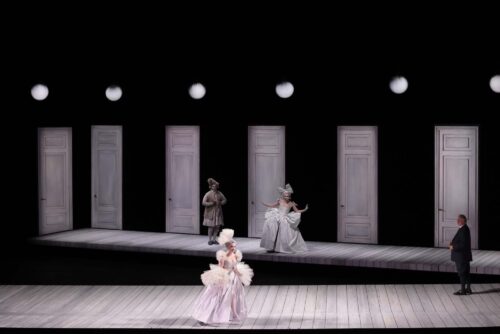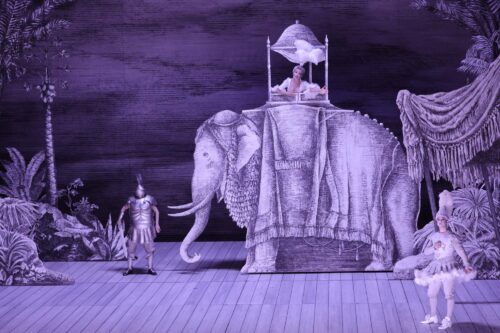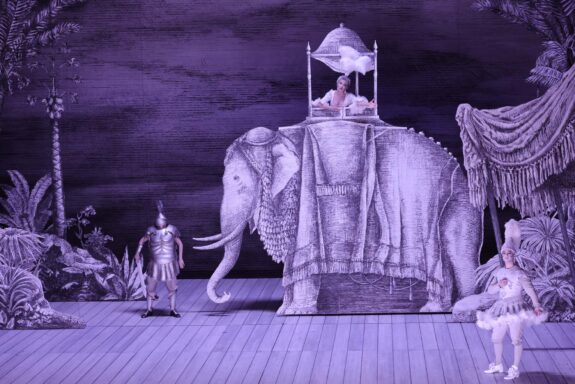 Italy Florian Leopold Gassmann’s L’opera seria: Soloists, Teatro alla Scala Orchestra and Les Talens Lyriques / Christophe Rousset (conductor). Teatro alla Scala, Milan, 3.4.2025. (CR)
Italy Florian Leopold Gassmann’s L’opera seria: Soloists, Teatro alla Scala Orchestra and Les Talens Lyriques / Christophe Rousset (conductor). Teatro alla Scala, Milan, 3.4.2025. (CR)

Just as warfare is the continuation of policy by other means, so the eighteenth-century librettist Ranieri de’ Calzabigi stepped up his campaign against the perceived absurdities of Baroque opera seria, progressing from creating a more Classically reformed version of the operatic genre with Gluck in Orfeo ed Euridice (1762) and Alceste (1767) to biting satire in L’opera seria (1769). Set to music by Florian Leopold Gassmann and premiered at Vienna, it sends up the existing conventions of opera as an artistic genre as well as the pretensions of those who create and promote it.
Laurent Pelly’s new production for La Scala follows that house’s recent mounting of older repertoire, by Cavalli and Vinci, which traces the roots of Italian operatic comedy. But Gassmann’s work is even more intriguing as an opera that reflects upon the nature of the art form of which La Scala has been one of the foremost proponents in the world for two-and-a-half centuries. Gassmann’s work stands at a pivotal moment in the development of opera, given the new heights to which Mozart was about to take it, but also in looking ahead to other pieces which lampoon the practice of opera, such as that composer’s Der Schauspieldirektor, in a double bill with Salieri’s Prima la musica e poi le parole; Donizetti’s Le convenienze ed inconvenienze teatrali; and Richard Strauss’s Ariadne and Capriccio. L’opera seria pre-empts elements in all of these.
Such works already involve their own dimension of metatheatre. But Pelly’s production adds another of his own, in that the performance of Gassmann’s work is essentially channelled through the perspective of the impresario Fallito, sung with fluency and directness here by Pietro Spagnoli. Clad in a modern-day suit, he looks around at the bare stage and out to us in the auditorium, in order to survey the blank slate of the theatre upon which he seeks to create a new opera as the Overture plays. Stagehands in impersonal black dress emerge like shadowy imps from behind the scene, here, as throughout the performance. Gassmann’s opera then proceeds with its characters in more or less correct eighteenth-century dress, but in austere tones of white, grey, and black, with a few doors for the entrances and exits of the main protagonists during the initial plans for the opera in Act I, followed by the rehearsal in Act II.
If it doesn’t quite seem that Pelly engages with the real vivacity of the work in these acts, he has a broader aim in view, which is to show that, however far off from the eighteenth century we may be, very little has changed in the practice of opera over that time, and the problems the impresario has to contend with today are hardly different from those of his predecessors back then. Likewise with the poet Delirio, who sports a contemporary tie underneath his overcoat and waistcoat, bridging the two eras, and sung with heft and authority by Mattia Olivieri. The composer is by no means set up on a pedestal, as Sospiro remains a flamboyant character entirely in eighteenth-century attire, though with a sharply coiffed wig that is surely meant to be reminiscent of a punk rocker’s mohican. Giovanni Sala takes the part with corresponding colour and flair in his performance.
Notwithstanding Pelly’s simple presentation of the opera, and the occasional difficulty in telling one character apart from another owing to indistinct costumes, there is sufficient charisma on the part of the performers to bring out the opera’s wit. There is also enough comedy in Calzabigi’s libretto to make all the other connections with conditions today – the impresario’s need to economise and keep costs down, as well as demands on the audience’s attention with a shorter work; overbearing singers, especially the prima donna; disagreements among composer, librettist, and singers; a romantic relationship between the composer and one of the sopranos; and trouble caused by the dance troupe and the separate composer, Passagallo, of the ballet numbers.
Calzabigi’s other targets relate more specifically to the practice of opera seria – which many operagoers will be sufficiently acquainted with now (e.g. through the works of Handel and Vivaldi) to recognise: the apparent lack of artistic integrity in substituting one aria text for the music of another, and singers’ habits of transferring their own favourite arias into other operas; the phenomenon of the castrato (which is tellingly written by Gassmann, instead, for a florid tenor, even though it would certainly have been possible to cast the role for a real castrato in the 1760s); and the overwrought librettos of Baroque opera. The deceased Silvio Stampiglia and Apostolo Zeno are mentioned, but no doubt Calzabigi really intended the then still alive Metastasio as the object of his scorn, in his satire upon simile arias where he likens a situation of danger with an irate dolphin in pursuit of a school of tuna.

Act III brings everything together in the improbable exoticism of a Baroque theatrical spectacle – complete with extravagant French dances – with singers in feathers and hooped skirts set in the context of a typically loosely based, ancient historical drama in India (‘L’Orenzebe’) though still with backdrops in grisaille. Reported audience disapproval and incompetence by the backstage technicians leading to the disintegration of the scenery bring the performance to a close, as well as the flight of the impresario. Further bickering ensues among the others, which now extends to the three sopranos’ mothers (all male singers in drag in a further dig at operatic inclinations, for cross-dressing and disguises) as to whose offspring is the best performer. Out of the chaos they swear an oath to make life difficult for all impresarios, which at least makes an ironic resolution to all the comic mayhem.
Initially the three sopranos sound similar in vocal quality, but in Act II the rehearsal of their various numbers brings out more distinction among them. Julie Fuchs gives an exuberant account of Stonatrilla, the prima donna, maintaining precise intonation and solid timbre in her melodic leaps and roulades. Andrea Carroll brings a more sedate clarity to the part of the second soprano, while Serena Gamberoni exerts coquettish charm as Porporina, the third, who has a flirtation with the composer. Josh Lovell evinces agility and dignity as the male, castrato lead, Ritornello. Alberto Allegrezza, Lawrence Zazzo, and Filippo Mineccia introduce waspish humour as the three mothers in drag – pantomime dames without overdoing their arch, camp characters.
Christophe Rousset presides over his group Les Talens Lyriques in the pit, bolstered by additional performers from the La Scala Orchestra. They offer robust support in a score that displays much variety, showing that Gassmann could skilfully ape the conventions of opera seria with its musical affectations (he had written such operas himself from the late-1750s onwards) while also looking ahead to the freer form of comic ensembles that Mozart would go on to develop in his masterpieces. The orchestra are unflagging in energy, and Rousset also puts in a turn with a wild harpsichord solo between the failed end of the opera within and Gassmann’s denouement, just as virtuosos like Handel would have done between scenes. The whole project is tremendous fun, and the clash of personalities and ambitions ensure that the entertainment is more than just a series of in-jokes about the theatrical world but a witty comedy of manners.
Curtis Rogers
Production:
Director and Costume designer – Laurent Pelly
Set designer – Massimo Troncanetti
Lighting – Marco Giusti
Choreography – Lione Hoche
Cast:
Fallito – Pietro Spagnoli
Delirio – Mattia Olivieri
Sospiro – Giovanni Sala
Ritornello – Josh Lovell
Stonatrilla – Julie Fuchs
Smorfiosa – Andrea Carroll
Porporina – Serena Gamberoni
Passagallo – Alessio Arduini
Bragherona – Alberto Allegrezza
Befana – Lawrence Zazzo
Caverna – Filipo Mineccia
Dancer – María Martín Campos
Chorus of dancers – Dilan Şaka, Haiyang Guo, Xhieldo Hyseni

I just saw this in Britain, thanks to the generosity of ‘Arte’. I was very grateful for this well-chosen treat for Christmas, as our BBC appears to have given up on the usual and expected offerings, during the Festive Season, of classy and colourful shows, which most of us cannot easily attend live productions of. It was, to me, an unfamiliar opera, the witty invention of which was to reflect on the nature of opera itself. An utterly charming and intelligent pleasure!